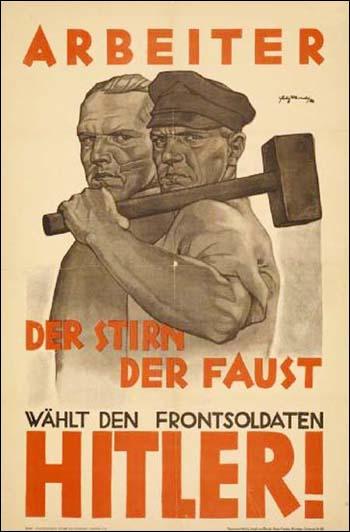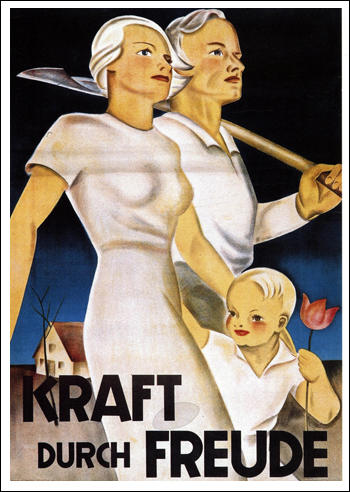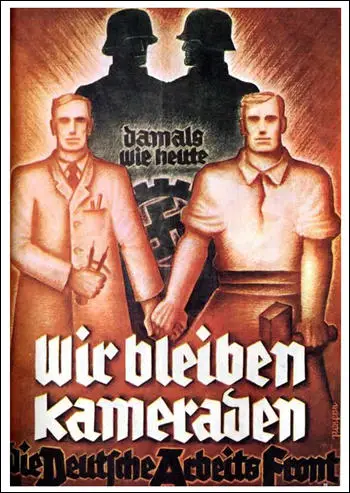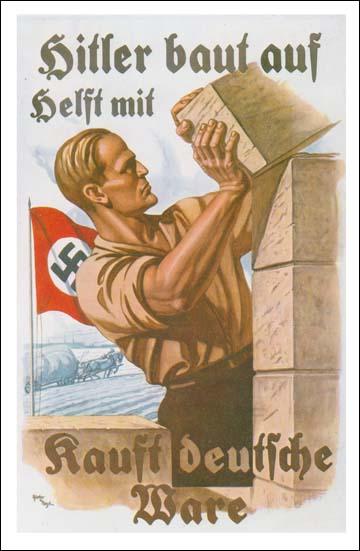Classroom Activity on Trade Unions in Nazi Germany
Adolf Hitler had been hostile towards trade unionism since his youth. Konrad Heiden, a journalist who investigated Hitler's time in Vienna, pointed out that as a young man he had come under the influence of Karl Lueger. His main opponent at the time was Victor Adler, the chairman of the Social Democratic Workers' Party (SDAP). Adler was Jewish and this had a major impact on the development of his political philosophy. "But whatever Hitler learned or thought he had learned from his model, Lueger, he learned far more from his opponent. And this opponent, whom he combated from the profound hatred of his soul, is and remains plain ordinary work. Organized, it calls itself labour movement, trade union, Socialist Party. And, or so it seems to him, Jews are always the leaders." Hitler was also aware that Adler's hero, Karl Marx, was also a Jew.
Mass unemployment resulted in more German people voting for right-wing parties. As William L. Shirer has pointed out, politicians such as Hitler "thrive only... when the masses were unemployed, hungry and desperate". In the election in November 1932 the Nazi Party won 230 seats, making it the largest party in the Reichstag. The German National Party, won nearly a million additional votes. However the German Social Democrat Party (133) and the German Communist Party (89) still had the support of the urban working class and Hitler was deprived of an overall majority in parliament. In numerical terms, the socialist parties obtained 13,228,000 votes compared to the 14,696,000 votes recorded for the Nazis and the German Nationalists.
Soon after Hitler became chancellor in January 1933 he announced new elections. Hermann Goering called a meeting of important industrialists where he told them that the election would be the last in Germany for a very long time. He explained that Hitler "disapproved of trade unions and workers' interference in the freedom of owners and managers to run their concerns." Goering added that the NSDAP would need a considerable amount of of money to ensure victory. Those present responded by donating 3 million Reichmarks. As Joseph Goebbels wrote in his diary after the meeting: "Radio and press are at our disposal. Even money is not lacking this time."
Behind the scenes Goering, who was minister of the interior in Hitler's government, was busily sacking senior police officers and replacing them with Nazi supporters. These men were later to become known as the Gestapo. Goering also recruited 50,000 members of the Sturm Abteilung (SA) to work as police auxiliaries. Goering then raided the headquarters of the German Communist Party (KPD) in Berlin and claimed that he had uncovered a plot to overthrow the government. Leaders of the KPD were arrested but no evidence was ever produced to support Goering's accusations. He also announced he had discovered a communist plot to poison German milk supplies.
Thousands of members of the Social Democrat Party and trade union activists were arrested and sent to recently opened concentration camps. Left-wing election meetings were broken up by the Sturm Abteilung (SA) and several candidates were murdered. Newspapers that supported these political parties were closed down during the election. Although it was extremely difficult for the opposition parties to campaign properly, Hitler and the Nazi party still failed to win an overall victory in the election on 5th March, 1933. The Nazi Party received 43.9% of the vote and only 288 seats out of the available 647. The increase in the Nazi vote had mainly come from the Catholic rural areas who feared the possibility of an atheistic Communist government.
Adolf Hitler proclaimed May Day, 1933, as a national holiday and arranged to celebrate it as it had never been celebrated before. Trade union leaders were flown to Berlin from all parts of Germany. Joseph Goebbels staged the greatest mass demonstration Germany had ever seen. Hitler told the workers' delegates: "You will see how untrue and unjust is the statement that the revolution is directed against the German workers." Later that day Hitler told a meeting of more than 100,000 workers that "reestablishing social peace in the world of labour" would soon begin. (19)
The next day, Hitler ordered the Sturm Abteilung (SA) to destroy the trade union movement. Their headquarters throughout the country were occupied, union funds confiscated, the unions dissolved and the leaders arrested. Large numbers were sent to concentration camps. Within a few days 169 different trade unions were under Nazi control.
Hitler gave Robert Ley the task of forming the German Labour Front (DAF). Ley, in his first proclamation, stated: "Workers! Your institutions are sacred to us National Socialists. I myself am a poor peasant's son and understand poverty... I know the exploitation of anonymous capitalism. Workers! I swear to you, we will not only keep everything that exists, we will build up the protection and the rights of the workers still further."
Primary Sources

(Source 2) Dr. Robert Ley, Social Policy in the New Germany (1938)
The trade-unions that were swayed by Marxist teaching did not want social peace. They calculated that their chances of acquiring political power would improve with the growing dissatisfaction of the workers. One of the first necessities with which the Hitler Government found itself faced was that of dissolving the organisations that kept alive the antagonism between employers and employees. They were replaced by the German Labour Front.
(Source 3) William Shirer, was an American journalist working in Nazi Germany during the 1930s.
Despite his harassed life, the businessman made good profits. The businessman was also cheered by the way the workers had been put in their place under Hitler. There were no more unreasonable wage demands. Actually, wages were reduced a little despite a 25 per cent rise in the cost of living. And above all, there were no costly strikes. In fact, there were no strikes at all. The Law Regulating National Labour of January 20, 1934, known as the Charter of Labour, had put the worker in his place and raised the employer to his old position of absolute master - subject, of course, to interference by the all-powerful State.

(Source 5) An anonymous German worker published a book entitled Hitler Calls This Living in 1939.
If England were to increase its land forces in the same ratio to the population as Germany has done - that is to say, by 400,000 men - it would partially solve its unemployment problem. By building palaces or tremendous new offices for the Prime Minister and his Cabinet colleagues, or covering the country with a network of Autobahnen, the residue of the unemployed could be at once absorbed. Eight thousand men worked on the construction of Herr Hitler's new chancellery, "the largest and most palatial Government edifice in Europe," and the cost, including furnishings, probably exceeded 150 million Reichsmarks... We must also remember that in recent years factory methods in Nazi Germany have taken on a very different tempo from what was formerly the custom. Work has been considerably speeded up. Piece-work has been organised accorclingly, and wage-rates have in many cases been reduced in order to lower the cost of production.

(Source 7) Song sung by members of the German Labour Front (c. 1936)
We demand from ourselves service to the end,
Even when no eyes are upon us. We know that we should love our Fatherland
More than our own life.
We vow that no one shall outdo us in loyalty,
That our life shall be one great labour-service for Germany.
So in this solemn hour we pray for blessing on the oath we take,
We thank thee, Führer, that we now have seen thee,
Do thou behold us as thine own creation?
May our hearts ever beat with thy heart's pulses,
Our lives find inspiration in thy love,
Behold us here! Thy Germany are we!
| (Source 8) Days lost in strikes and unemployment in Germany | ||
|---|---|---|
| Date | Days lost in strikes (in thousands) | % of workers registered as unemployed |
| 1927 | 6,144 | 8.8 |
| 1928 | 20,339 | 8.4 |
| 1929 | 4,251 | 13.1 |
| 1930 | 4,029 | 15.3 |
| 1931 | 1,890 | 23.3 |
| 1932 | 1,130 | 30.1 |
| 1933 | 96 | 26.3 |
| 1934 | 14.9 | |
| 1935 | 11.6 | |
| 1936 | 8.3 | |
| 1937 | 4.6 | |
(Source 9) Hermann Schmidt, a senior figure in the Labour Front, was interviewed in 1938 about life in the Nazi Party.
I hate the treatment of the Jews. I think it is a bad side of the movement and I will have nothing to do with it. I did not join the party to do that sort of thing. I joined the party because I thought and still think that Hitler did the greatest Christian work for twenty-five years. I saw seven million men rotting in the streets - often I was there too, and no one, not even the Churches, seemed to care that it was a wicked thing that children of God should be thus left to rot. .. Then Hitler came and he took all those men off the streets and gave them health and security and work at least for the time being. Wasn't that a Christian act? So it was because I am a Catholic that I said, "I will join the party and I will do all I can to help a movement which refuses to let the young manhood of this nation be wasted."

Questions for Students
Question 1: How does the author of source 2 justify the banning of trade unions?
Question 2: Select evidence from this unit that helps to explain why, according to source 3, "businessmen made good profits" in Nazi Germany.
Question 3: We do not know the author of source 5. Does this make it worthless as historical evidence?
Question 4: What do sources 1, 4, 6, 7, 10 tell us about the methods used by the Nazi Party to influence the mood of the German worker?
Answer Commentary
A commentary on these questions can be found here
